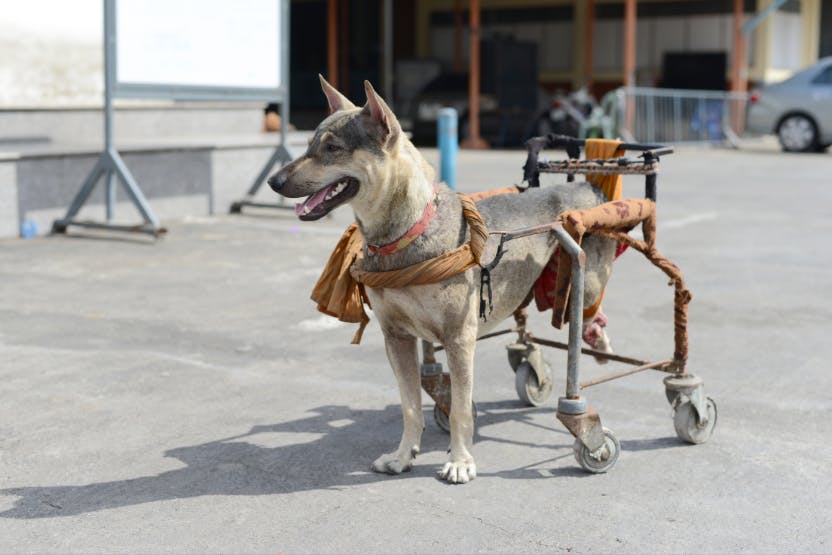- Home
- Dog Wellness
- 5 Helpful Mobility Aids for Dogs with Disabilities
4 min read
5 Helpful Mobility Aids for Dogs with Disabilities

By Adam Lee-Smith
Published: 09/23/2022, edited: 09/25/2022
Reviewed by a licensed veterinary professional: Dr. Linda Simon, MVB MRCVS
Save on pet insurance for your pet
You don't have to choose between your pet and your wallet when it comes to expensive vet visits. Prepare ahead of time for unexpected vet bills by finding the pawfect pet insurance.
Overview
Just like people, some pets need assistance with mobility. You may have an elderly dog that's suffering from arthritis, a pooch born with a congenital defect, or a pup that was injured in an accident.
Whatever the situation, a dog with a disability may need extra help climbing stairs or walking. Luckily, there are many moblity aids out there that'll help your pupper to get around with ease. Here's a look at some mobility aids for dogs with disabilities that'll help get your mutt moving again!
Wheelchairs
People aren't the only ones who can use wheelchairs! You'll find several different types of wheelchairs for dogs on the market to suit a range of needs and disabilities.
Many of the best doggy wheelchairs are made of aluminum, a light yet durable material. Wheels support either side of your dog's body so they can still stand upright while getting some extra support from underneath. A dog wheelchair can help with various conditions and needs, from hip dysplasia to recovery from surgery.
Most dog wheelchairs come with interchangeable wheels that work on different terrains. This means your dog can still walk through the grass or on a stony path without issues. Many wheelchairs are fully adjustable and can be fined tuned to your dog's weight and height. Most wheelchairs also allow dogs to go to the bathroom without any hassle.
Overall, a dog wheelchair is one of the "ultimutt" mobility aids for dogs with disabilities.
Dog prosthetics
Consider a prosthetic if your dog was born without a leg or lost a leg due to an accident or injury. While some dogs get around fine on 3 legs, a prosthetic can significantly improve a pup's quality of life.
Because dogs put 60% of their weight on their front paws, missing a front leg means over half a dog's weight is on one leg. This means dogs with 3 legs have to change their balance and movement. This will put additional stress on their remaining legs, which could cause health problems later in life.
There are many different types of dog prosthetics, from paws to front legs to hind legs. As no two amputations are the same, dog prosthetics need to be custom-made for each dog. However, getting the perfect prosthetic for your dog has never been easier, thanks to modern technology like 3D printing.
Prosthetics let dogs distribute their weight correctly and walk naturally, which improves general mobility. There's no better mobility aid than a prosthetic for a dog missing one of their paws.
Body harnesses
Body harnesses, also called dog support slings, are useful for helping dogs with mobility issues that don't need as much support as a wheelchair offers. Body harnesses wrap around your dog's torso and have handles on the top. You can pull gently on these handles to help your dog stand, climb stairs, or get up ramps.
Body harnesses aren't ideal for dogs with severe mobility issues. They're better suited to pups with early-stage arthritis or hip dysplasia who just need extra help in more difficult situations.
Support slings are comfortable for dogs to wear while giving your dog plenty of freedom to move. They can also be used in conjunction with a wheelchair if your pupper is taking a bit of time getting used to their new set of wheels.
Pet stairs and ramps
Pet stairs and ramps are a simple solution for dogs with trouble jumping into a vehicle or onto your comfy bed. Sometimes pet stairs aren't even for dogs with disabilities — your pint-sized pup might just be too short to get on the couch! They are also a good investment for breeds prone to IVDD such as Dachshunds and Bassett Hounds.
Pet stairs let your dog get to hard-to-reach places without putting much strain on their joints by jumping. Ramps work the same way, just with a gradual incline rather than steps.
Pet stairs come in various shapes and sizes — some have non-skid surfaces to help dogs stay surefooted. Pet stairs will save you some manual labor as you won't have to keep picking up your pup. Your back and knees will thank you in the long run!
Joint braces
Like humans, a dog's weakened joints might need a little extra support. Joint braces compress and stabilize the joint to increase mobility and reduce pain.
There are joint braces made especially for hip support in case your dog has hip dysplasia or arthritis. Hip braces won't prevent a condition from worsening, but they are helpful therapeutic tools that can be used alongside vet treatment.
Splints and braces for a dog's paws can aid in recovery from injury and help manage pain from a medical condition. By stabilizing the paw, these braces allow for normal movement. These braces are adjustable and can be changed as your dog's leg swells or heals.
Never use one of these items without first consulting your vet as they may do more harm than good if used inappropriately.
Protect your pet from mobility problems like hip dysplasia and arthritis
Insure your pet as soon as "pawssible" to save money on expensive treatments for reduced mobility. Wag!'s pet insurance comparison tool helps you find the "pawfect" plan in seconds!
You may also like
